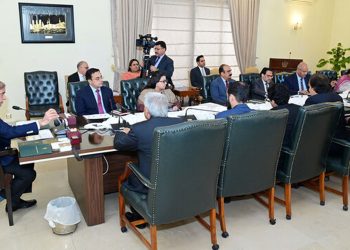The government has identified various economic factors as well as “rising economic and political uncertainty” responsible for fuelling price hikes in the country amid expectations of a further increase in the already elevated inflation in the coming months.
Political and economic uncertainty is another potential factor adding to the rising price level, according to the Ministry of Finance’s monthly economic report for March 2023, which was published on Friday.
Other than that, economic uncertainty caused by the relative demand and supply gap of necessities, exchange rate depreciation, and recent increases in administered prices of petrol and diesel are expected to keep inflation at a high level.
“Due to the lagged effect of floods, the production losses especially of major crops have not yet been fully recovered. Consequently, the shortage of essential items has emerged and persisted. Inflation may further jack up as a result of the second round effect,” it added.
The CPI-based inflation rate for March 2023, which was scheduled to be published today (Saturday), was predicted to be close to 35%, compared to 31.5% for February 2023.
On April 4, 2023, the Monetary Policy Committee (MPC) will convene; there is a chance that the policy rate will increase from 20% to 22-23%.
Despite barriers and unpredictabilities, the economy is reportedly displaying consistent indications of fortitude, as evidenced by the current fiscal year’s contained fiscal and current account deficits.
“Furthermore, Pakistan is currently confronted with a shortage in external liquidity. Through demand management policies, the government is trying to limit the current account deficit, which will not transfer further pressure on dwindling reserves,” it said.
The government also has an intense drive to finish the Extended Fund Facility (EFF) plan of the International Monetary Fund (IMF), which includes the required policy changes and will further ease the financial account of the balance of payments. The goal of the policy changes is to more closely match national revenue with national expenditures.
On the fiscal front, the government is working to achieve fiscal consolidation through the management of expenditures, the imposition of austerity measures, and the mobilization of revenues in order to lower the total fiscal deficit.
According to the study, the economic hardship caused on by the stabilization program’s delay has increased economic uncertainty, which has kept inflationary expectations high.
Inflationary hopes are not decreasing despite the State Bank of Pakistan’s (SBP) contractionary monetary policy.
Furthermore, purchasing in bulk during Ramadan may result in a demand-supply imbalance and an increase in the price of necessities. However, the government is aware of this and has already enlisted the support of all provincial administrations to guarantee a steady supply of necessities.
Inflation in March may stay above what was seen in February. By the conclusion of the current fiscal year, it will be expected that recent monetary policy restraints and efforts at fiscal consolidation, along with administrative, policy, and relief measures, will lessen the inflationary pressure.
The average MEI over the first eight months of the current fiscal year shows that domestic economic activity is continuing to slow down. This appears to be caused by a lack of industrial dynamism, resulting in accelerating inflation and eroding investors’ and consumers’ buying power. Negative growth in exports and imports is another indicator of this.
Data from the BOP show that the trade deficit in goods and services greatly decreased from $2.6 billion in February 2022 to $1.8 billion in February 2023, a decrease of 30.8% YoY. On a month-over-month basis, it did, however, rise slightly to $1.8 billion from $1.7 billion in January. On a month-over-month basis, exports of products and services fell slightly to $2.77 billion from $2.8 billion in January. On an annual basis, it fell by 19.2%. The amount of products and services imported has remained stable and dropped by 24.2% YoY.
Due to an improved situation after the reduction of differences between the inter-bank and open markets, which subsequently allowed adjustments of the exchange rate, remittances rose by 5.0% on a MoM basis to $2.0 billion in February 2023 as compared to $1.9 billion in January 2023. Another element that significantly adds to the current account’s improvement in February is the $200 million primary income balance.
So, instead of $230 million in January 2023, the current account shortfall was limited to $74 million. Due to slow growth in the main trading partners and restrained domestic economic activity, exports, and imports will likely stay at their current level in March.
However, thanks to beneficial seasonal and Ramadan variables, remittances will likely continue to increase. The current account deficit is likely to stay on the lower side when these and other elements are taken into consideration.
By managing expenses and raising revenues, the government is seeking fiscal consolidation to lower the overall fiscal deficit. Fiscal finances are improving as a result of these actions. From July to January of FY2023, the fiscal deficit decreased from 2.8% of GDP to 2.3% of GDP, and the primary balance is now in surplus as a result of a sharp drop in non-markup spending.
Despite unprecedented challenges caused by a slowdown in economic activity and import compression, the Federal Board of Revenue’s (FBR) tax collection is presently increasing at 18%. The government is determined to maximize revenue collection and meet the full-year goal, as evidenced by its current performance.
To address a sizable fiscal imbalance, the government’s stabilization agenda is led by fiscal consolidation. In FY2023, it is predicted that the overall fiscal imbalance as a percentage of GDP will be significantly reduced thanks to prudent expenditure management and a successful resource mobilization strategy.






